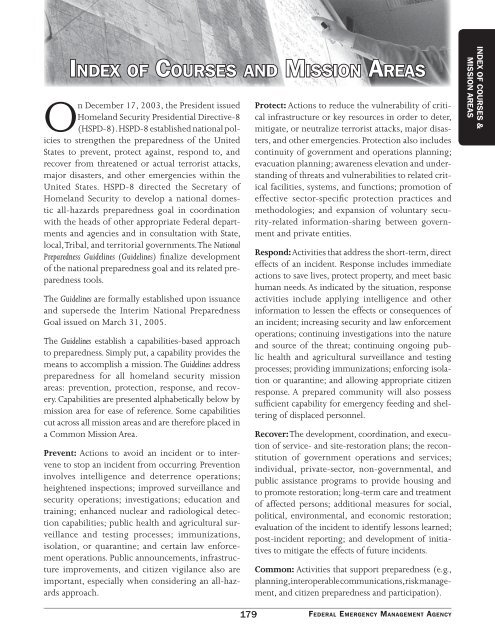enrollment for emi courses - Emergency Management Institute ...
enrollment for emi courses - Emergency Management Institute ...
enrollment for emi courses - Emergency Management Institute ...
You also want an ePaper? Increase the reach of your titles
YUMPU automatically turns print PDFs into web optimized ePapers that Google loves.
EmE r g E n c y ma n a g E m E n t In s t I t u t E • 2010-2011 • ca t a l o g of co u r s E s<br />
IN d E x O F CO u r S E S A N d mISSION Ar E A S<br />
On December 17, 2003, the President issued<br />
Homeland Security Presidential Directive-8<br />
(HSPD-8). HSPD-8 established national policies<br />
to strengthen the preparedness of the United<br />
States to prevent, protect against, respond to, and<br />
recover from threatened or actual terrorist attacks,<br />
major disasters, and other emergencies within the<br />
United States. HSPD-8 directed the Secretary of<br />
Homeland Security to develop a national domestic<br />
all-hazards preparedness goal in coordination<br />
with the heads of other appropriate Federal departments<br />
and agencies and in consultation with State,<br />
local, Tribal, and territorial governments. The National<br />
Preparedness Guidelines (Guidelines) finalize development<br />
of the national preparedness goal and its related preparedness<br />
tools.<br />
The Guidelines are <strong>for</strong>mally established upon issuance<br />
and supersede the Interim National Preparedness<br />
Goal issued on March 31, 2005.<br />
The Guidelines establish a capabilities-based approach<br />
to preparedness. Simply put, a capability provides the<br />
means to accomplish a mission. The Guidelines address<br />
preparedness <strong>for</strong> all homeland security mission<br />
areas: prevention, protection, response, and recovery.<br />
Capabilities are presented alphabetically below by<br />
mission area <strong>for</strong> ease of reference. Some capabilities<br />
cut across all mission areas and are there<strong>for</strong>e placed in<br />
a Common Mission Area.<br />
Prevent: Actions to avoid an incident or to intervene<br />
to stop an incident from occurring. Prevention<br />
involves intelligence and deterrence operations;<br />
heightened inspections; improved surveillance and<br />
security operations; investigations; education and<br />
training; enhanced nuclear and radiological detection<br />
capabilities; public health and agricultural surveillance<br />
and testing processes; immunizations,<br />
isolation, or quarantine; and certain law en<strong>for</strong>cement<br />
operations. Public announcements, infrastructure<br />
improvements, and citizen vigilance also are<br />
important, especially when considering an all-hazards<br />
approach.<br />
179 .<br />
Protect: Actions to reduce the vulnerability of critical<br />
infrastructure or key resources in order to deter,<br />
mitigate, or neutralize terrorist attacks, major disasters,<br />
and other emergencies. Protection also includes<br />
continuity of government and operations planning;<br />
evacuation planning; awareness elevation and understanding<br />
of threats and vulnerabilities to related critical<br />
facilities, systems, and functions; promotion of<br />
effective sector-specific protection practices and<br />
methodologies; and expansion of voluntary security-related<br />
in<strong>for</strong>mation-sharing between government<br />
and private entities.<br />
Respond: Activities that address the short-term, direct<br />
effects of an incident. Response includes immediate<br />
actions to save lives, protect property, and meet basic<br />
human needs. As indicated by the situation, response<br />
activities include applying intelligence and other<br />
in<strong>for</strong>mation to lessen the effects or consequences of<br />
an incident; increasing security and law en<strong>for</strong>cement<br />
operations; continuing investigations into the nature<br />
and source of the threat; continuing ongoing public<br />
health and agricultural surveillance and testing<br />
processes; providing immunizations; en<strong>for</strong>cing isolation<br />
or quarantine; and allowing appropriate citizen<br />
response. A prepared community will also possess<br />
sufficient capability <strong>for</strong> emergency feeding and sheltering<br />
of displaced personnel.<br />
Recover: The development, coordination, and execution<br />
of service- and site-restoration plans; the reconstitution<br />
of government operations and services;<br />
individual, private-sector, non-governmental, and<br />
public assistance programs to provide housing and<br />
to promote restoration; long-term care and treatment<br />
of affected persons; additional measures <strong>for</strong> social,<br />
political, environmental, and economic restoration;<br />
evaluation of the incident to identify lessons learned;<br />
post-incident reporting; and development of initiatives<br />
to mitigate the effects of future incidents.<br />
Common: Activities that support preparedness (e.g.,<br />
planning, interoperable communications, risk management,<br />
and citizen preparedness and participation).<br />
FEd E r A L Em E r g E N C y mA N A g E m E N T Ag E N C y<br />
InDEx Of cOursEs &<br />
mIssIOn arEas

















